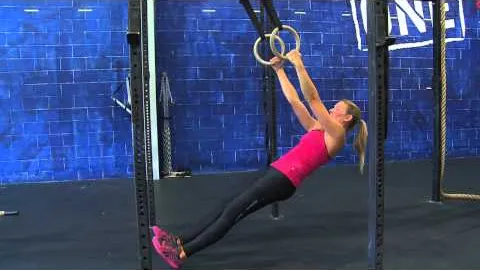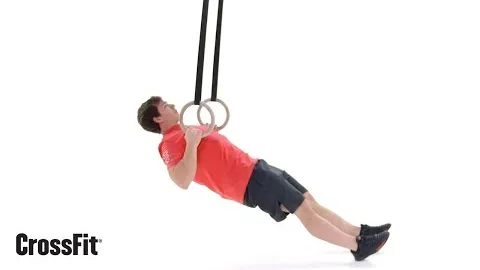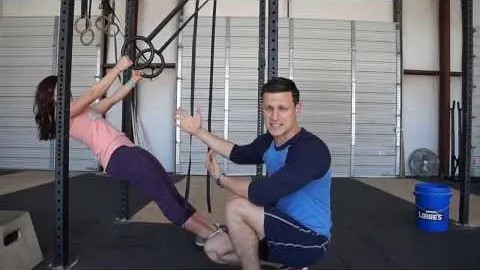



If you're looking to improve your upper body strength and stability, the ring row exercise is an excellent choice. This compound exercise primarily targets the muscles in your back, biceps, and shoulders, while also engaging the core and lower body muscles for stability. In this article, we will explore the benefits, proper form, variations, and tips for maximizing your results with the ring row exercise.
The ring row exercise offers several benefits for individuals of all fitness levels:
Strengthens the Upper Body: The ring row primarily targets the muscles in your back, including the latissimus dorsi, rhomboids, and trapezius. It also engages the biceps, shoulders, and forearms, helping to build overall upper body strength.
Improves Posture: Due to the nature of the exercise, the ring row helps to correct muscular imbalances and improve posture. By strengthening the muscles in your upper back, it counteracts the effects of prolonged sitting and hunching over electronic devices.
Enhances Core Stability: The ring row requires you to engage your core muscles to maintain a stable body position throughout the movement. This helps to improve your overall core strength and stability.
Promotes Muscular Balance: The ring row exercise targets the muscles that are often neglected in traditional pulling exercises, such as pull-ups or lat pulldowns. By incorporating ring rows into your routine, you can achieve a well-rounded muscular balance in your upper body.
To perform the ring row exercise with proper form, follow these steps:
Set Up: Adjust the height of the rings so that they are slightly above your waist level. Stand facing the rings, and grip them with an overhand grip. Keep your palms facing inward.
Body Position: Walk your feet forward until your body is at an angle, leaning back with your arms fully extended. Your body should be in a straight line from your head to your heels.
Retract the Shoulder Blades: Begin the movement by retracting your shoulder blades. Squeeze them together and down, engaging your back muscles.
Bend Your Elbows: Pull your chest towards the rings by bending your elbows. Keep your body in a straight line as you pull, and avoid sagging your hips or letting your shoulders shrug up.
Full Contraction: Pause for a moment when your chest touches the rings, and squeeze your shoulder blades together to achieve a full contraction of the back muscles.
Return to Starting Position: Slowly lower your body back to the starting position, fully extending your arms. Maintain control throughout the movement.
Once you have mastered the basic ring row exercise, you can add variations to increase the intensity and challenge your muscles further. Here are a few variations you can try:
Single-Arm Ring Rows: Perform the ring row exercise while gripping the rings with one hand only. This variation increases the demand on the working arm and engages your core more to maintain stability.
Weighted Ring Rows: Hold a dumbbell or a weighted vest while performing the ring row exercise. This adds additional resistance and helps to build more strength in your muscles.
Elevated Feet Ring Rows: Place your feet on an elevated surface, such as a box or bench, while performing the ring rows. Elevating your feet increases the difficulty by placing more weight on your upper body.
To make the most of your ring row exercise and achieve optimal results, consider the following tips:
Progress Gradually: Start with a comfortable level of intensity and gradually increase the difficulty as your strength improves. This will help prevent injuries and allow for steady progress.
Maintain Proper Form: Focus on maintaining proper form throughout the exercise. This ensures that the target muscles are effectively engaged and reduces the risk of strain or injury.
Control the Tempo: Perform the ring row exercise with a controlled tempo, emphasizing the eccentric (lowering) phase of the movement. This enhances muscular development and increases time under tension.
Rest and Recover: Allow your muscles to rest and recover between workouts. Aim for at least 48 hours of recovery before performing ring rows again. This will help prevent overtraining and promote muscle growth.
Incorporating the ring row exercise into your fitness routine can have a transformative effect on your upper body strength and stability. By following proper form, exploring variations, and implementing the tips provided, you'll be well on your way to reaping the numerous benefits of this versatile exercise. So, grab a pair of rings and get ready to row your way to a stronger and more stable upper body!
If you're looking for a gym, fitness club or yoga studio, you've come to the right place.
You can find information about gyms in your area. Browse catalog of gyms and find gyms with classes which are you looking for.
On gym page you can find simple information like address, phone or website. You can find list of available classes. You can check availability of personal training or small group classes. On place page you can also see information about open hours.
You can find gyms near you with amenities, courts, studios and equipments.
Use our map to find gym at your city or district.
In Gym Navigator you can find list of exercises with movies for many body parts.
You can browse exercises catalog and find exercises the best of you.
You can also find exercises grouped into workout plans, which you can use to improve you body. Each routine show you exercises one by one and give you possibility to count you progress and count down rest time.